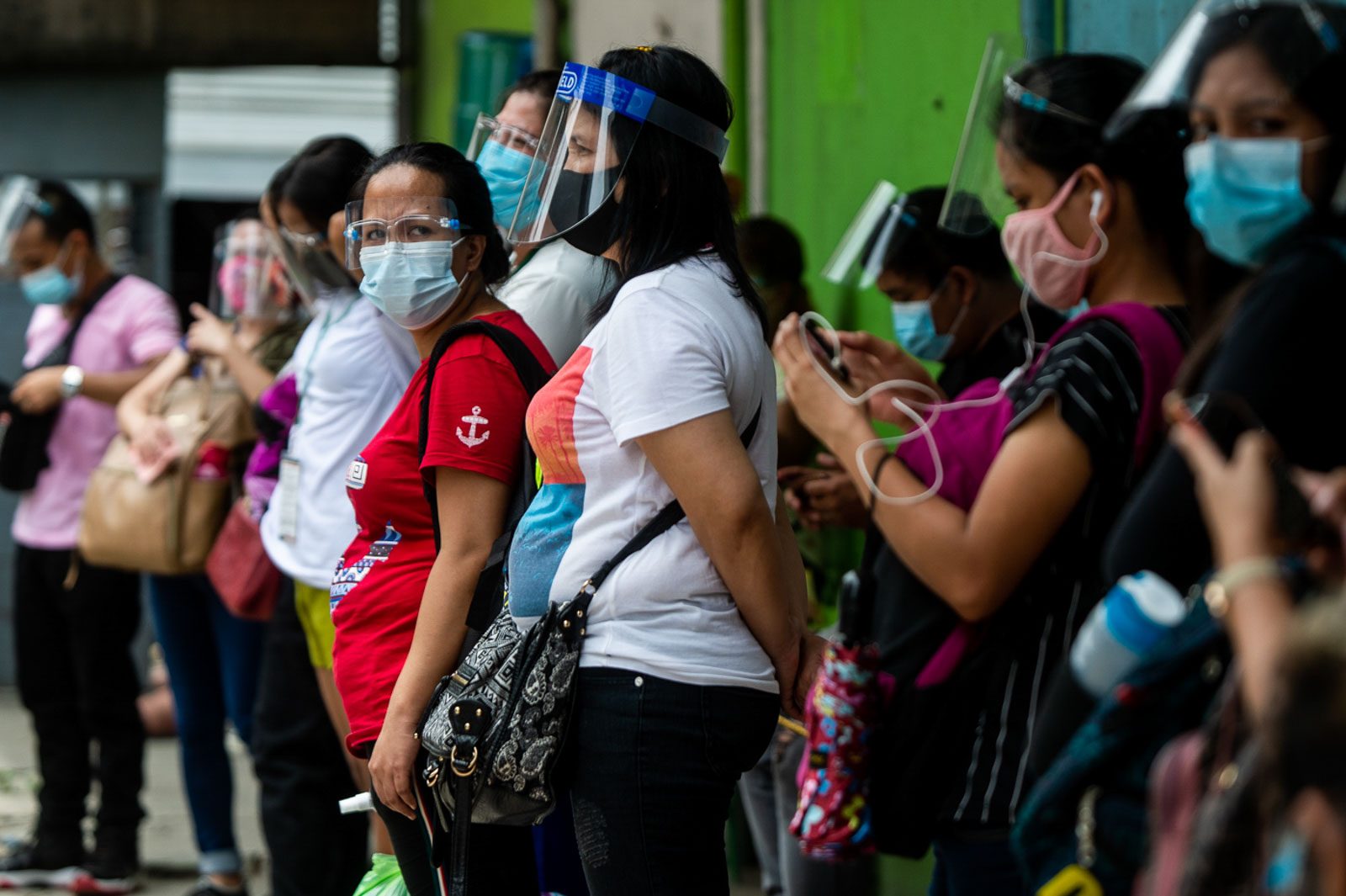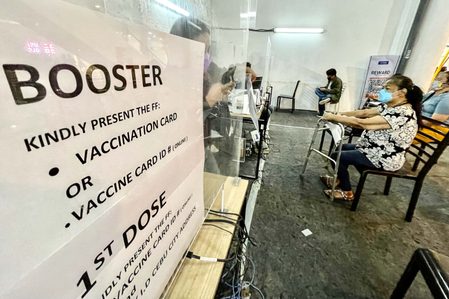SUMMARY
This is AI generated summarization, which may have errors. For context, always refer to the full article.

MANILA, Philippines – In the recent week, the number of new coronavirus cases plateaued in all islands groups and Metro Manila. Roughly 60% of Filipinos have been fully vaccinated, including 10.1 million minors. Booster uptake is slower, with just 12.15 million shots (17%) administered to the 46.47 million Filipinos who were eligible for an additional dose, as of April 3.
Here’s what we’re watching this week of April 10, 2022:
Recombi-what?
Scientists around the world continue to track the evolution of the virus, watching out for variants and recombinants that have the potential to alter the pandemic landscape. Recently, the World Health Organization (WHO) named three recombinants it was tracking: XD, XE, and XF. It’s the latest reminder – yet again – that the pandemic is not over.
- Recombinants emerge when two different virus strains infect a cell simultaneously and exchange genes between them. In this case, XD and XF are recombinants of Delta and Omicron, while XE is a recombinant of Omicron BA.1 and BA.2
- What we know so far:
- In terms of impact on transmissibility, severity, and the performance of diagnostics and vaccines, there is no evidence of change for XD compared to Omicron. XF, meanwhile, is also of a Delta and BA.1 lineage found in the United Kingdom.
- XE has some evidence to suggest “modestly increased” transmissibility of 10% compared to Omicron BA.2, meaning it is 1.1 times more transmissible, if confirmed. Compared to its Omicron parent, there is currently no evidence of change when it comes to severity and the performance of diagnostics and vaccines.
- Some scientists see XD as a little more concerning than other recombinants so far. “If *any* of these recombinants were to act much differently than their parent, it might be XD,” said Tom Peackok, a virologist at the Department of Infectious Disease at Imperial College.
- For purposes of tracking, XD is considered a variant under monitoring, while XE is considered as Omicron.
- Why are these popping up now? Recombinants are common to coronaviruses and are expected to take place, especially with the level of transmission occurring both on a regional and global level.
- What does it mean for our response? Dr. Babatunde Olowokure, WHO Western Pacific Region Health Security and Emergency director, told reporters this means that countries should anticipate and prepare for surges.
- “We need to be vigilant, we need to continue testing, and we need to continue to identify any unusual events and surges as quickly as possible and share that information so that we can end this phase of the pandemic,” Olowokure said in a recent press conference.
More on variants
Still on variant watch, scientists in China announced on April 4 that they had sequenced a new subvariant of Omicron, labeled BA.1.1. This comes as China experiences a dramatic increase in cases being driven by the highly contagious Omicron variant, after staving off a deluge of cases for the past two years.
- The subvariant was reportedly first spotted in Suzhou, a city next to Shanghai. It did not match other variants or subvariants recorded in a global database.
- Scientists say it is not a cause for concern for now, but it does underscore the ongoing risks of the virus as it continues to circulate at an “intense level” globally.
- “As long as this virus continues to circulate, we are at risk. It can evolve, mutate, and throw up variants of concern,” WHO’s Olowokure said.
- The WHO has flagged the risks that come with the fact that variants and recombinants are emerging at a time when pandemic restrictions are being eased, and testing, as well as sequencing efforts, are seeing sizeable downgrades.
- Notably, the United Kingdom ended its free testing for most people on April 1, while other countries with robust testing systems like Denmark have also scaled back. It’s a situation that leaves the world less prepared to spot future variants, the New York Times reported.
- In particular, national surveys for COVID-19 tests in the UK – where hundreds of thousands of people were tested at random each month – helped in the detection of new variants and outbreaks. In other words, it was proactive, “rather than waiting for tests to come from clinics or hospitals,” the Times said. Must read piece here.
- So it’s worth reiterating to decision makers at this point: To stay one step ahead, “It is not the virus, but the systems [for response] that can sustainably control COVID-19 surges while avoiding significant disruptions to society.”
- There is still a long way to go. Epidemiologist Dr. Katelyn Jetelina said: “Two years into this pandemic, this virus hasn’t provided any hints about where it’s going. Coronaviruses typically evolve in a ladder-like pattern. We haven’t seen this yet for SARS-CoV-2.
- What a ladder-like pattern looks like: One major lineage, and every few years, a new variant sweeps and the others go extinct.
- What SARS-CoV-2 is like now: Still unpredictable, with variants popping up from unexpected lines. “The next big variant hasn’t been coming from the last: Omicron didn’t come from Delta, and Delta didn’t come from Alpha.”
- Dr. Trevor Bedford, an evolutionary virologist, told the United States Food and Drug Administration earlier this week that with currently available data, an “Omicron-like” event could happen every 1.5 to 10.5 years.
Fourth shot not yet needed for general population
European health officials said it was still “too early” to recommend second COVID-19 boosters to the general population. But health regulators approved a second booster for the elderly aged 80 years and older, largely looking at evidence from Israel. A fourth dose has also been allowed for the immunocompromised.
- The Times summarized findings from Israeli data:
- For vulnerable groups, “A second booster, given at least four months after the first, saw antibody levels replenished without raising further safety concerns.”
- “For most adults with healthy immune systems…there was no clear evidence that protection against severe disease afforded by vaccines was diminishing.”
- Europe follows the United States, which has green-lit a second booster for people 50 years and older. In the UK, immunocompromised individuals and people aged over 75, or who lived in a nursing home, were eligible for another booster.
- In the Philippines, health officials have asked for people at least 60 years old and up, along with the immunocompromised, to be allowed to get a fourth shot.
Focusing on BARMM
Vaccine czar Carltio Galves Jr. told President Rodrigo Duterte earlier this week that one of the biggest problems of the country’s vaccine rollout was low vaccine coverage in the Bangsamoro Autonomous Region in Muslim Mindanao (BARMM), where just 27% of the region’s target population was fully vaccinated.
- Coverage levels are extremely low at this point in the government’s rollout, where supply is no longer an issue and officials have had over a year to prepare and refine distribution systems.
- What’s holding people back? Galvez pointed to false information on the vaccine, cultural beliefs (some people are reluctant, never having received vaccines before), and accessibility – or rather lack of it.
- We can’t neglect BARMM. Low vaccine coverage in the region means that millions remain exposed to higher risks for severe disease and death. The region also has a limited health capacity, which means they are among those that can least afford a surge in cases.
- A Rappler investigation looked into major bottlenecks in the country’s vaccine drive. Aside from issues raised by Galvez, regions like BARMM once again expose how long-neglected problems in the Philippines’ health system, including a lack of health workers and the absence of easily accessible primary health centers, are holding back efforts to exit the pandemic.
In case you missed it: The Department of Health wants boosters for minors aged 12 to 17 and has asked the FDA for an amendment to current emergency use authorizations. More below:
– Rappler.com
Add a comment
How does this make you feel?

There are no comments yet. Add your comment to start the conversation.